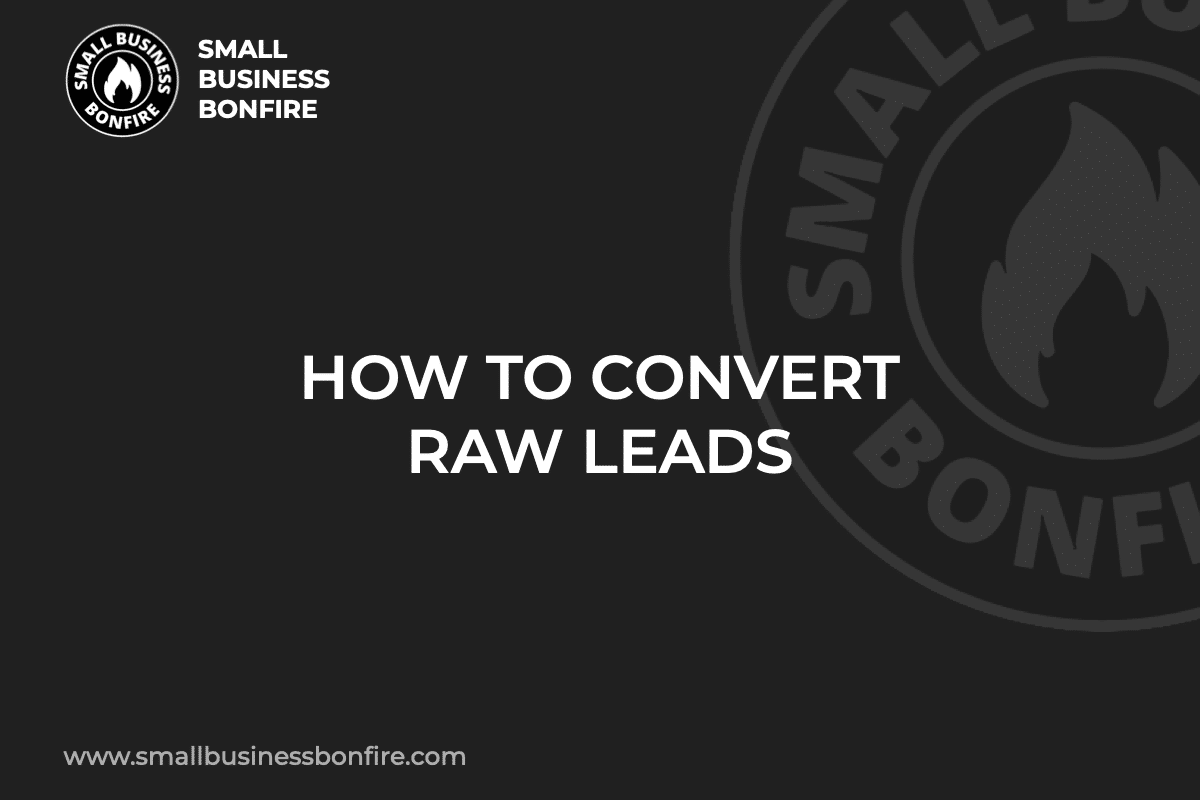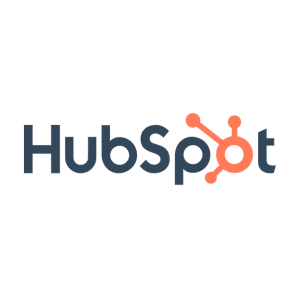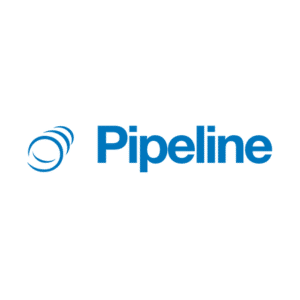Does your company struggle to distinguish a high-quality lead from a bad one? Or is your team pursuing each prospect with the same amount of effort?
If you fall into either of these categories, don’t worry; you’re not alone. Several small businesses struggle to qualify and convert the highest quality leads.
Hi, my name is AJ! I recently sold my company for multiple seven figures. After doing that, I launched Small Business Bonfire to help growing entrepreneurs avoid the numerous mistakes I made.
Before my business became successful, my team and I had to learn how to qualify and convert raw leads.
What do I mean by this? Keep reading to learn how to boost sales and find your best prospects!
Key Takeaways
- A raw lead is someone at the top of your sales funnel who has shown little or no interest in your offerings.
- Strategies like lead scoring help your team separate high-quality raw leads from low-quality ones.
- Establishing a company-wide definition of what determines a raw lead is critical.
- Giving raw leads a choice to opt-out shows your business values their time and attention.
Related Reading: Best Small Business CRM
SBB Featured Partners
What are Raw Leads?
Raw leads are unqualified leads at the top of your sales funnel.
Typically, businesses have minimal information on these leads.
For instance, it’s challenging to determine whether a raw lead is a perfect-fit prospect, a lead that requires nurturing, or an unqualified lead.
Therefore, managing these leads effectively is crucial because it helps secure more sales and find your target audience.
Using a customer relationship management (CRM) system can aid in this process by organizing and tracking raw leads.
There are several ways to secure raw leads, including the following methods:
- Content downloads
- Website visits
- Webinars
- Social media interactions
- In-person events (trade shows, group meetings, etc.)
A raw lead is easy to target and manage compared to other leads!
In the upcoming section, I’ll review the various kinds of raw leads!
Types of Raw Leads
There are four kinds of raw leads, including the following:
- Inbound
- Outbound
- Referral
- Third-party
Here’s everything you need to know about these leads and how they impact the entire sales process!
Inbound Raw Leads
Inbound raw leads are individuals who have voluntarily shown interest in your business or products.
These leads often occur because of your team’s marketing efforts.
Further, these leads generally come from sources like:
- Website visits
- Blog posts
- Social media
- Content downloads
Typically, these leads have engaged with your brand online and decided to provide their contact information, showing a level of interest in your products or services.
Inbound raw leads are highly valuable as they’ve shown a proactive approach, but they still require qualification and nurturing to transform into paying customers.
Outbound Raw Leads
Outbound raw leads are potential customers your business has identified and approached proactively through targeted outreach efforts.
Usually, a company locates these leads through methods like:
- Direct mail
- Telemarketing
- Email campaigns
Unlike inbound leads, outbound leads may not have shown an initial interest or awareness in your product or service.
Therefore, they usually require more strategic engagement and convincing to guide them down the sales funnel!
Referral Raw Leads
Referral raw leads are potential customers who are introduced to your business through a recommendation or referral from any of the following sources:
- An existing customer
- A partner
- Any other trusted source
This type of lead often comes with a certain level of trust and interest since someone they trust refers to them.
As a result, referral leads can be easier to convert than other leads, but they still require effective management and nurturing.
Despite the initial interest, qualifying and nurturing these leads is crucial to ensure they’re a good fit for your products or services.
Third-Party Raw Leads
A third-party raw lead is a potential customer your business acquires from external sources.
Typically, these external sources are companies or platforms specializing in lead generation.
These sources provide businesses with a list of contacts, often tailored to specific industries or demographics.
Further, these leads have yet to express interest in your business or products, making them challenging to pursue and convert.
Therefore, these leads require highly customized engagement strategies to spark their interest and guide them through the sales cycle.
Raw Leads Vs. MQL Leads Vs. SQL Leads
Did you know there are several kinds of leads?
For instance, a raw lead differs from a marketing qualified lead. And there are also sales qualified leads.
Let’s see the differences your sales team must know about these leads!
Raw Leads
As previously mentioned, a raw lead hasn’t shown interest in buying your products or services (yet).
It’s crucial to effectively manage raw leads because they’re at the top of the sales funnel and can convert to repeat customers.
A raw lead can be anyone from a perfect match for what your company offers to someone who has no interest or need for your products or services.
Marketing Qualified Leads
A marketing qualified lead (MQL) is someone the marketing team identifies as high quality.
Therefore, the department emphasizes lead nurturing for this category of people.
Defining leads as marketing qualified means the customer profile meets specific pre-determined criteria, such as:
- Level of interest in your products or services
- Demographics
- Amount of social media engagement
Sales Qualified Leads
A sales qualified lead (SQL) is someone your sales team has recruited.
Also, sales teams typically determine that these leads are ready for the next stage in the sales cycle.
These high-quality leads will likely do business with you and your team.
Therefore, if they don’t purchase your products or services after the first point of contact, nurturing them further is essential.
As you can see, the difference between sales qualified and raw leads is that SQLs meet several criteria for your target audience.
On the other hand, as you manage raw leads, you’ll quickly see that some are unqualified.
How to Handle Raw Leads
What’s the best way to distinguish qualified from unqualified raw leads?
Below, I’ve listed a six-step process for the best ways of handling raw leads!
These steps include the following actions:
- Establish a raw lead definition for your company
- Align your sales and marketing teams
- Utilize lead scoring to prioritize perfect-fit prospects
- Allow leads to opt-out
- Use various communication channels
- Send updates
Let’s look at these steps in closer detail!
Step 1: Agree on the Definition of Raw Lead
Before you can effectively manage and convert leads, it’s critical to establish a universally agreed-upon definition of what a raw lead is within your company.
Sometimes, sales and marketing departments have differing ideas of what determines a raw lead.
Therefore, a consensus ensures alignment across all sectors, particularly between sales and marketing.
Also, a clear definition of a raw lead outlines the characteristics and traits that qualify a prospect as a raw lead.
Therefore, these actions set the stage for a unified approach to handling and nurturing leads.
Further, this agreement eliminates confusion and miscommunication and contributes to a streamlined lead management process.
As a result, your business increases the chances of successful conversions and a streamlined sales pipeline!
Step 2: Align Sales and Marketing Teams
Aligning your sales and marketing departments is a strategic move that can significantly boost your lead conversion process.
Further, this alignment fosters collaboration, with both teams working towards a common goal: converting raw leads into paying customers.
When these two departments work in harmony, the following things can happen within your business:
- Two departments share valuable insights and strategies
- Teams can offer feedback to tailor the lead nurturing process more effectively
- Your company can address the needs and interests of prospects
- Your marketing activities are more in line with customer preferences
Also, this alignment can result in a more seamless and efficient sales pipeline.
An efficient pipeline reduces the risk of losing potential customers due to miscommunication or disorganized efforts.
Essentially, aligning your sales and marketing departments fosters a unified approach to lead management that can enhance your business’s productivity, efficiency, and bottom line!
Step 3: Prioritize Raw Leads when Lead Scoring
Incorporating lead scoring into your strategy is crucial for prioritizing your raw leads effectively.
For instance, lead scoring is a method to rank potential customers according to the perceived value each lead brings to your business.
By assigning values to your leads based on specific characteristics and behaviors, you can identify which ones are ready to engage in the buying cycle.
Further, this process helps to save time and resources by focusing your efforts on the most promising leads.
Additionally, lead scoring can enhance alignment between marketing and sales teams.
For example, with a shared understanding of lead quality, both teams can make more informed decisions about when to pass leads from marketing to sales.
Also, this information helps departments learn how to tailor their approaches to nurturing and closing leads.
Put simply, using lead scoring to prioritize raw leads can result in a more efficient sales process and improve conversion rates.
Step 4: Give Raw Leads the Opportunity to Opt Out
Enabling raw leads to opt-out is a crucial aspect of your lead management strategy.
The opt-out choice respects the freedom and preferences of potential customers.
As a result, it also showcases your business’s commitment to customer satisfaction rather than aggressive sales tactics.
Further, it helps to maintain a healthy and clean sales pipeline.
For example, if a lead opts out, they are likely not interested in your products or services, or the timing isn’t right.
Therefore, persisting with such leads can waste valuable time and resources that your team could spend nurturing leads that show more promise.
Consequently, allowing an opt-out option results in the following things:
- It streamlines your sales efforts
- It improves lead quality
- It enhances the overall effectiveness of your lead conversion process
Step 5: Try Different Communication Channels
Exploring various communication channels can be a significant help in the quest to convert raw leads.
It’s important to remember that people have diverse preferences when it comes to communication.
For instance, some prospects may prefer emails, while others resonate more with social media, phone calls, or face-to-face meetings.
Being flexible and versatile in your communication approach increases the chances of effectively reaching and engaging your leads.
Also, utilizing various forms of communication allows for personalization, as it enables you to cater to the unique preferences of each lead.
In essence, adopting multiple communication channels does the following things:
- Broadens your reach
- Enhances engagement with leads
- Contributes to a higher conversion rate
It’s crucial to understand your target audience when selecting which communication channels your team relies on.
For instance, if your target audience is most active on Facebook, joining that platform and connecting with potential and current customers is wise.
On the other hand, if your target audience doesn’t like receiving phone calls, ensure your sales team doesn’t pursue leads that way.
When companies use communication channels their target audience doesn’t like, it’s off-putting and results in more lost sales opportunities.
Step 6: Send Relevant Updates
Providing relevant updates to your leads plays a significant role in lead conversion.
For instance, sending updates lets you keep the conversation going, maintain your leads’ interest, and guide them further down the sales funnel.
Also, by sharing updates about your company’s news, product releases, or service enhancements, you demonstrate ongoing value to your leads and keep your offerings in mind.
Further, this practice fosters trust and helps build a relationship with your leads, which can eventually result in more conversions.
Sending relevant updates is essential. However, you must ensure these updates are relevant and valuable to your leads.
Spamming leads with irrelevant information can have the opposite effect and push them away.
Therefore, when sending messages, understanding your leads, their interests, and their needs is vital.
Whether through email newsletters, social media posts, or personalized messages, relevant updates can significantly influence your conversion rate and number of sales!
Challenges with Managing Raw Leads
Managing raw leads can pose several challenges that may hamper the success of your lead conversion efforts.
For instance, some of the most prevalent challenges include the following things:
- It’s hard to identify qualified leads from low-quality ones
- There can be a lack of lead engagement
- Teams can follow up with people at the wrong time
Let’s look at each of these challenges in greater detail!
Identifying Qualified Leads
One of the biggest challenges is distinguishing between qualified and unqualified leads.
Not all raw leads will convert into sales; some might not be a good fit for your product or service.
Therefore, businesses spend significant time and resources separating the right prospects from the wrong ones.
It’s crucial to ensure the distinguishing process isn’t too time-consuming.
When companies spend significant time trying to find the best leads, it can result in missed sales opportunities and lower customer satisfaction.
Lack of Lead Engagement
Another common obstacle is generating and maintaining interest among raw leads.
Engaging potential customers meaningfully requires understanding their needs, interests, and buying behaviors.
As you can imagine, learning all these things about a potential customer requires time and energy.
Despite businesses’ best efforts, many raw leads often remain unresponsive or indifferent.
As frustrating as this can be, it’s crucial to move on from leads who don’t respond promptly and instead focus on finding other prospects!
Inappropriate Follow-Up Timing
Lastly, determining the right time to follow up can prove challenging.
For example, reaching out to prospects too soon might seem pushy, while too late could result in lost opportunities.
Further, each lead may be at a different stage in the buying cycle, making it difficult to ascertain the ideal timing for follow-up.
These challenges underscore the need for a robust and structured lead management strategy.
Systematically addressing these issues can significantly improve your raw lead conversion rate!
Final Thoughts on Raw Leads
There is everything you need to know about raw leads!
Remember, a raw lead is someone who has either shown very little interest or no interest in your company’s products or services.
Still, raw leads can contain people who match your target audience, so it’s crucial to nurture this segment.
Let us know in the comments section how you and your team focus on the right raw leads!
And good luck creating a system to distinguish a qualified lead from a low-value one! It’s essential because it ensures your team is efficient!
Newsletter Signup
Join The Leads Field Guide Newsletter for tips, strategies and (free) resources for growing your leads, and closing more deals.




